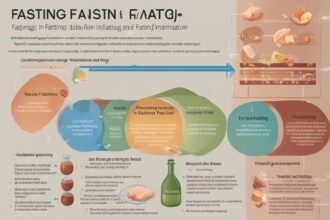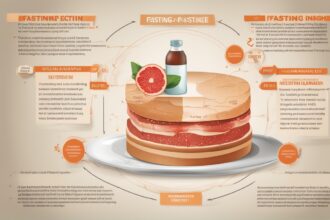Hey there, health enthusiasts! If you’ve been exploring ways to boost your wellness naturally, you’ve likely stumbled upon the incredible fasting benefits. fasting isn’t just a trendy diet hack—it’s a practice rooted in history and backed by modern science for its profound effects on the body. One of the most exciting areas of research today is how fasting can help combat inflammation, a sneaky culprit behind many chronic diseases. In this deep dive, we’ll unpack the connection between fasting and inflammation, explore the science behind these fasting advantages, and share actionable tips to incorporate fasting into your life. Let’s get started on this journey to better health!
What Is Inflammation, and Why Should You Care?
Inflammation is your body’s natural response to injury or infection. Think of it as your immune system’s way of saying, “Hey, we’ve got a problem here!” Acute inflammation—like the redness and swelling from a cut—is temporary and helpful. However, chronic inflammation is a different beast. It’s a low-grade, persistent state that can silently damage tissues and contribute to conditions like heart disease, diabetes, and even cancer (Harvard Health, 2020). Stress, poor diet, and sedentary lifestyles often fuel this fire. So, where do the fasting benefits come in? Emerging research suggests that fasting can act like a reset button, helping to dial down this chronic inflammatory response. Let’s explore how.
How Fasting Impacts Inflammation: The Science Behind It
When you fast, your body shifts gears. Without incoming food, it moves from storing energy to burning stored fat for fuel, a process called ketosis. But the magic doesn’t stop there. Fasting also triggers a cascade of cellular processes that directly influence inflammation. One key player is autophagy, where cells clean out damaged components and recycle them for energy. Studies show that autophagy, ramped up during fasting, can reduce inflammatory markers in the body (Jordan et al., 2019). Additionally, fasting lowers levels of pro-inflammatory cytokines—molecules that signal inflammation—while boosting anti-inflammatory pathways (Longo & Mattson, 2014). These fasting health perks aren’t just theoretical; they’re measurable in blood tests and clinical trials. Pretty cool, right?
Types of Fasting and Their Anti-Inflammatory Effects
Not all fasting is created equal, and different approaches can yield unique fasting benefits for inflammation. Let’s break down a few popular methods:
- Intermittent Fasting (IF): This involves cycling between eating and fasting periods, like the 16:8 method (fast for 16 hours, eat during an 8-hour window). Research suggests IF can lower C-reactive protein (CRP), a key marker of inflammation (Patterson & Sears, 2017).
- Time-Restricted Eating (TRE): Similar to IF but focused on eating within a specific daily window, TRE helps align your body’s circadian rhythm, potentially reducing systemic inflammation (Wilkinson et al., 2020).
- Water Fasting: A more intense approach, this involves consuming only water for a set period (usually 24–72 hours). Short-term water fasting has been linked to reduced inflammatory markers, though it’s not for everyone (Horne et al., 2015).
- Alternate-Day Fasting (ADF): You alternate between normal eating days and very low-calorie or fasting days. ADF shows promise in decreasing inflammation in overweight individuals (Varady et al., 2013).
Each method has its own set of fasting advantages, so you can choose one that fits your lifestyle and health goals. Always consult a healthcare provider before diving into longer fasts, especially if you have underlying conditions.
Practical Tips to Maximize Fasting Benefits for Inflammation
Ready to tap into the fasting health perks for reducing inflammation? It’s not just about skipping meals—how you approach fasting matters. Here are some practical tips to get the most out of your fasting journey:
- Start Small: If you’re new to fasting, don’t jump into a 3-day water fast. Begin with a 12:12 intermittent fasting schedule (12 hours fasting, 12 hours eating) and gradually increase the fasting window.
- Stay Hydrated: Dehydration can stress your body and worsen inflammation. Drink plenty of water, herbal teas, or black coffee during fasting periods.
- Focus on Nutrient-Dense Foods: When you break your fast, prioritize anti-inflammatory foods like leafy greens, fatty fish, nuts, and berries to complement the fasting benefits.
- Listen to Your Body: Fasting shouldn’t feel like torture. If you’re dizzy, overly fatigued, or irritable, scale back and reassess your approach.
- Avoid Overeating Post-Fast: Bingeing after a fast can spike inflammation. Ease back into eating with small, balanced meals.
These tips can help you harness the fasting advantages without unnecessary stress on your system. Remember, consistency is key—fasting is a long-term tool, not a quick fix.
Who Should Be Cautious with Fasting?
While the fasting benefits for inflammation are impressive, this practice isn’t a one-size-fits-all solution. Certain groups should approach fasting with caution or avoid it altogether. Pregnant or breastfeeding women, for instance, need consistent nutrition for themselves and their babies. People with eating disorders may find fasting triggers unhealthy behaviors. Those with medical conditions like diabetes or low blood pressure should consult a doctor, as fasting can affect blood sugar and medication needs (Longo & Mattson, 2014). Even if you’re healthy, overdoing fasting—especially prolonged fasts—can lead to nutrient deficiencies or stress on the body, potentially increasing inflammation instead of reducing it. Balance is everything, so tailor fasting to your unique needs and always prioritize safety.
Beyond Inflammation: Other Fasting Health Perks
While we’ve focused on how fasting tames inflammation, the fasting benefits extend far beyond that. Fasting is like a multi-tool for health, offering perks across various systems. It can improve insulin sensitivity, making it a potential ally against type 2 diabetes. It supports brain health by enhancing focus and protecting against neurodegenerative diseases through the production of brain-derived neurotrophic factor (BDNF) (Mattson et al., 2017). Fasting may even promote longevity by activating pathways linked to cellular repair and stress resistance. When you combine these fasting health perks with reduced inflammation, you’ve got a powerful recipe for overall wellness. Isn’t it amazing how something as simple as skipping a meal (strategically, of course) can do so much?
So, what’s the takeaway from all this? Fasting isn’t just a passing fad—it’s a scientifically supported practice with tangible fasting benefits, especially when it comes to tackling inflammation. By giving your body a break from constant digestion, you’re allowing it to focus on repair, reset, and renewal. Whether you’re drawn to intermittent fasting or a short water fast, the key is to start slow, stay mindful, and pair fasting with a healthy lifestyle. Inflammation doesn’t stand a chance when you’ve got these fasting advantages on your side! Have you tried fasting yet? Drop a comment below with your experiences or questions—I’d love to hear how it’s working for you. Here’s to healthier, happier days ahead!
References
- Harvard Health. (2020). Understanding acute and chronic inflammation. Harvard Medical School. Retrieved from https://www.health.harvard.edu/staying-healthy/understanding-acute-and-chronic-inflammation
- Horne, B. D., Muhlestein, J. B., & Anderson, J. L. (2015). Health effects of intermittent fasting: Hormesis or harm? A systematic review. The American Journal of Clinical Nutrition, 102(2), 464-470. https://doi.org/10.3945/ajcn.115.109553
- Jordan, S., Tung, N., Casanova-Acebes, M., et al. (2019). Dietary intake regulates the circulating inflammatory monocyte pool. Cell, 178(5), 1102-1114. https://doi.org/10.1016/j.cell.2019.07.050
- Longo, V. D., & Mattson, M. P. (2014). Fasting: Molecular mechanisms and clinical applications. Cell Metabolism, 19(2), 181-192. https://doi.org/10.1016/j.cmet.2013.12.008
- Mattson, M. P., Longo, V. D., & Harvie, M. (2017). Impact of intermittent fasting on health and disease processes. Ageing Research Reviews, 39, 46-58. https://doi.org/10.1016/j.arr.2016.10.005
- Patterson, R. E., & Sears, D. D. (2017). Metabolic effects of intermittent fasting. Annual Review of Nutrition, 37, 371-393. https://doi.org/10.1146/annurev-nutr-071816-064634
- Varady, K. A., Bhutani, S., Klempel, M. C., et al. (2013). Alternate day fasting for weight loss in normal weight and overweight subjects: A randomized controlled trial. Nutrition Journal, 12, 146. https://doi.org/10.1186/1475-2891-12-146
- Wilkinson, M. J., Manoogian, E. N. C., Zadourian, A., et al. (2020). Ten-hour time-restricted eating reduces weight, blood pressure, and atherogenic lipids in patients with metabolic syndrome. Cell Metabolism, 31(1), 92-104. https://doi.org/10.1016/j.cmet.2019.11.004






